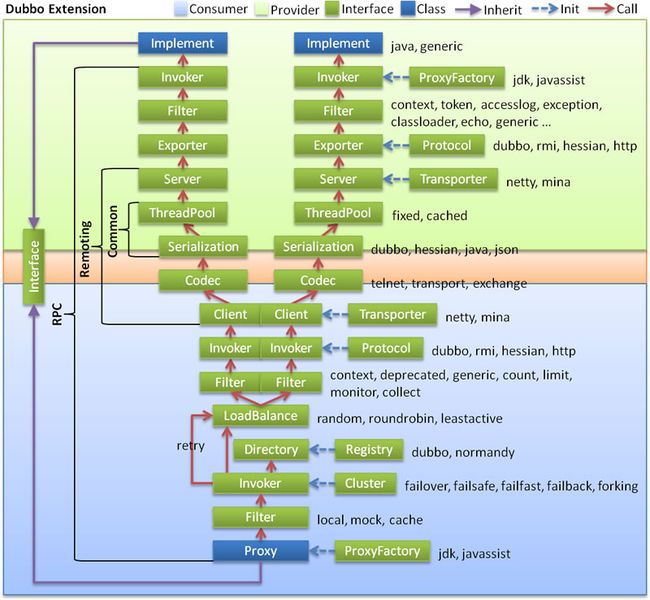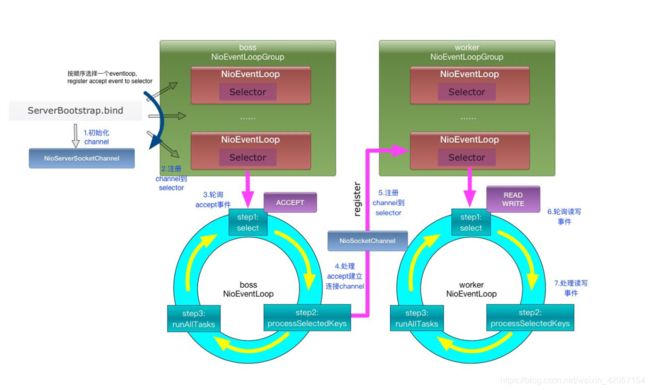Dubbo学习笔记:Dubbo-Spring整合demo及浅析
文章目录
-
- Dubbo整合demo
- dubbo高可用
-
- zookeeper宕机与dubbo直连
- 集群下dubbo负载均衡配置
-
- 负载均衡策略
- 整合hystrix,服务熔断与降级处理
-
- 1. 服务降级
- 2.集群容错
- 3.整合hystrix 服务熔断
-
- 1. 配置spring-cloud-starter-netflix-hystrix
- 2. 配置Provider端
- 3. 配置Consumer端
- dubbo原理 详见文档
-
- 1.RPC原理
- 2.netty通信原理
- 3.dubbo原理
-
-
- 3.1框架设计
- 3.2启动解析、加载配置信息(标签解析)
- 3.3服务暴露
- 3.4服务引用
- 3.5服务调用
-
Dubbo整合demo
- 需要使用zookeeper作为注册中心,使用maven作为包管理,配合spring/springboot搭建项目
- demo地址:https://github.com/chen-TR/gmall-dubbo
dubbo高可用
zookeeper宕机与dubbo直连
现象:zookeeper注册中心宕机,还可以消费dubbo暴露的服务。
原因:健壮性
- 监控中心宕机不影响使用,只是丢失部分采集数据
- 数据库宕掉后,注册中心仍能通过缓存提供服务列表查询。但不能注册新服务
- 注册中心对等集群,任意一台宕机后,将自动切换到另外一台可用服务器
- 注册中心全部宕机后,服务提供者(provider)和服务消费者(consumer)仍能通过本地缓存通讯
- 服务提供者无状态,任意一台宕机后,不影响使用
- 服务提供者全部宕机后,服务消费者应用将无法使用,并无限次重连等待服务提供者恢复
高可用:通过设计,减少系统不能提供服务的时间。
集群下dubbo负载均衡配置
在集群负载均衡时,Dubbo 提供了多种均衡策略,缺省为 random 随机调用。
负载均衡策略
- Random LoadBalance
随机,按权重设置随机概率。
在一个截面上碰撞的概率高,但调用量越大分布越均匀,而且按概率使用权重后也比较均匀,有利于动态调整提供者权重。 - RoundRobin LoadBalance
轮循,按公约后的权重设置轮循比率。
存在慢的提供者累积请求的问题,比如:第二台机器很慢,但没挂,当请求调到第二台时就卡在那,久而久之,所有请求都卡在调到第二台上。 - LeastActive LoadBalance
最少活跃调用数,相同活跃数的随机,活跃数指调用前后计数差。
使慢的提供者收到更少请求,因为越慢的提供者的调用前后计数差会越大。 - ConsistentHash LoadBalance
一致性 Hash,相同参数的请求总是发到同一提供者。
当某一台提供者挂时,原本发往该提供者的请求,基于虚拟节点,平摊到其它提供者,不会引起剧烈变动。算法参见:http://en.wikipedia.org/wiki/Consistent_hashing
缺省只对第一个参数 Hash,如果要修改,请配置
缺省用 160 份虚拟节点,如果要修改,请配置 - 一致性哈希和哈希的区别
可参考该博客
整合hystrix,服务熔断与降级处理
1. 服务降级
什么是服务降级?
当服务器压力剧增的情况下,根据实际业务情况及流量,对一些服务和页面有策略的不处理或换种简单的方式处理,从而释放服务器资源以保证核心交易正常运作或高效运作。
可以通过服务降级功能临时屏蔽某个出错的非关键服务,并定义降级后的返回策略。
向注册中心写入动态配置覆盖规则:
RegistryFactory registryFactory = ExtensionLoader.getExtensionLoader(RegistryFactory.class).getAdaptiveExtension();
Registry registry = registryFactory.getRegistry(URL.valueOf("zookeeper://10.20.153.10:2181"));
registry.register(URL.valueOf("override://0.0.0.0/com.foo.BarService?category=configurators&dynamic=false&application=foo&mock=force:return+null"));
其中:
- mock=force:return+null 表示消费方对该服务的方法调用都直接返回 null 值,不发起远程调用。用来屏蔽不重要服务不可用时对调用方的影响。
- 还可以改为 mock=fail:return+null 表示消费方对该服务的方法调用在失败后,再返回 null 值,不抛异常。用来容忍不重要服务不稳定时对调用方的影响。
2.集群容错
在集群调用失败时,Dubbo 提供了多种容错方案,缺省为 failover 重试。
Failover Cluster
失败自动切换,当出现失败,重试其它服务器。通常用于读操作,但重试会带来更长延迟。可通过 retries="2" 来设置重试次数(不含第一次)。
重试次数配置如下:
Failfast Cluster
快速失败,只发起一次调用,失败立即报错。通常用于非幂等性的写操作,比如新增记录。
Failsafe Cluster
失败安全,出现异常时,直接忽略。通常用于写入审计日志等操作。
Failback Cluster
失败自动恢复,后台记录失败请求,定时重发。通常用于消息通知操作。
Forking Cluster
并行调用多个服务器,只要一个成功即返回。通常用于实时性要求较高的读操作,但需要浪费更多服务资源。可通过 forks="2" 来设置最大并行数。
Broadcast Cluster
广播调用所有提供者,逐个调用,任意一台报错则报错 [2]。通常用于通知所有提供者更新缓存或日志等本地资源信息。
集群模式配置
按照以下示例在服务提供方和消费方配置集群模式
3.整合hystrix 服务熔断
Hystrix 旨在通过控制那些访问远程系统、服务和第三方库的节点,从而对延迟和故障提供更强大的容错能力。Hystrix具备拥有回退机制和断路器功能的线程和信号隔离,请求缓存和请求打包,以及监控和配置等功能(spring Cloud内置)
1. 配置spring-cloud-starter-netflix-hystrix
spring boot官方提供了对hystrix的集成,直接在pom.xml里加入依赖:
org.springframework.cloud
spring-cloud-starter-netflix-hystrix
1.4.4.RELEASE
然后在Application类上增加@EnableHystrix来启用hystrix starter:
@SpringBootApplication
@EnableHystrix
public class ProviderApplication {
2. 配置Provider端
在Dubbo的Provider上增加@HystrixCommand配置,这样子调用就会经过Hystrix代理。
@Service(version = "1.0.0")
public class HelloServiceImpl implements HelloService {
@HystrixCommand(commandProperties = {
@HystrixProperty(name = "circuitBreaker.requestVolumeThreshold", value = "10"),
@HystrixProperty(name = "execution.isolation.thread.timeoutInMilliseconds", value = "2000") })
@Override
public String sayHello(String name) {
// System.out.println("async provider received: " + name);
// return "annotation: hello, " + name;
throw new RuntimeException("Exception to show hystrix enabled.");
}
}
3. 配置Consumer端
对于Consumer端,则可以增加一层method调用,并在method上配置@HystrixCommand。当调用出错时,会走到fallbackMethod = "reliable"的调用里。
@Reference(version = "1.0.0")
private HelloService demoService;
@HystrixCommand(fallbackMethod = "reliable")
public String doSayHello(String name) {
return demoService.sayHello(name);
}
public String reliable(String name) {
return "hystrix fallback value";
}
dubbo原理 详见文档
1.RPC原理
![]()
2.netty通信原理
3.dubbo原理
3.1框架设计
![]()
- service业务层:用户关心的业务层,面向接口编程
- RPC 远程调用层:
- config 配置层:对外配置接口,以
ServiceConfig,ReferenceConfig为中心,可以直接初始化配置类,也可以通过 spring 解析配置生成配置类 - proxy 服务代理层:服务接口透明代理,生成服务的客户端 Stub 和服务器端 Skeleton, 以
ServiceProxy为中心,扩展接口为ProxyFactory - registry 注册中心层:封装服务地址的注册与发现,以服务 URL 为中心,扩展接口为
RegistryFactory,Registry,RegistryService - cluster 路由层:封装多个提供者的路由及负载均衡,并桥接注册中心,以
Invoker为中心,扩展接口为Cluster,Directory,Router,LoadBalance - monitor 监控层:RPC 调用次数和调用时间监控,以
Statistics为中心,扩展接口为MonitorFactory,Monitor,MonitorService - protocol 远程调用层:封装 RPC 调用,以
Invocation,Result为中心,扩展接口为Protocol,Invoker,Exporter
- config 配置层:对外配置接口,以
- Remoting远程通信层:
- exchange 信息交换层:封装请求响应模式,同步转异步,以
Request,Response为中心,扩展接口为Exchanger,ExchangeChannel,ExchangeClient,ExchangeServer - transport 网络传输层:抽象 mina 和 netty 为统一接口,以
Message为中心,扩展接口为Channel,Transporter,Client,Server,Codec - serialize 数据序列化层:可复用的一些工具,扩展接口为
Serialization,ObjectInput,ObjectOutput,ThreadPool
- exchange 信息交换层:封装请求响应模式,同步转异步,以
3.2启动解析、加载配置信息(标签解析)
- Dubbo通过
public class DubboBeanDefinitionParser implements BeanDefinitionParser类中的paese方法解析dubbo配置文件中的标签
private static BeanDefinition parse(Element element, ParserContext parserContext, Class<?> beanClass, boolean required) {
RootBeanDefinition beanDefinition = new RootBeanDefinition();
beanDefinition.setBeanClass(beanClass);
beanDefinition.setLazyInit(false);
String id = element.getAttribute("id");
....
// 判断bean的类型,做出相应的解析
if (ProtocolConfig.class.equals(beanClass)) {
for (String name : parserContext.getRegistry().getBeanDefinitionNames()) {
BeanDefinition definition = parserContext.getRegistry().getBeanDefinition(name);
PropertyValue property = definition.getPropertyValues().getPropertyValue("protocol");
if (property != null) {
Object value = property.getValue();
if (value instanceof ProtocolConfig && id.equals(((ProtocolConfig) value).getName())) {
definition.getPropertyValues().addPropertyValue("protocol", new RuntimeBeanReference(id));
}
}
}
} else if (ServiceBean.class.equals(beanClass)) {
String className = element.getAttribute("class");
if (className != null && className.length() > 0) {
RootBeanDefinition classDefinition = new RootBeanDefinition();
classDefinition.setBeanClass(ReflectUtils.forName(className));
classDefinition.setLazyInit(false);
parseProperties(element.getChildNodes(), classDefinition);
beanDefinition.getPropertyValues().addPropertyValue("ref", new BeanDefinitionHolder(classDefinition, id + "Impl"));
}
} else if (ProviderConfig.class.equals(beanClass))
parseNested(element, parserContext, ServiceBean.class, true, "service", "provider", id, beanDefinition);
} else if (ConsumerConfig.class.equals(beanClass)) {
parseNested(element, parserContext, ReferenceBean.class, false, "reference", "consumer", id, beanDefinition);
}
....
return beanDefinition;
- 而
DubboDefinitionParser中的beanclass是通过DubboNameSpaceHandler注册到容器中的-
@Override
public void init() {
registerBeanDefinitionParser("application", new DubboBeanDefinitionParser(ApplicationConfig.class, true));
registerBeanDefinitionParser("module", new DubboBeanDefinitionParser(ModuleConfig.class, true));
registerBeanDefinitionParser("registry", new DubboBeanDefinitionParser(RegistryConfig.class, true));
registerBeanDefinitionParser("monitor", new DubboBeanDefinitionParser(MonitorConfig.class, true));
registerBeanDefinitionParser("provider", new DubboBeanDefinitionParser(ProviderConfig.class, true));
registerBeanDefinitionParser("consumer", new DubboBeanDefinitionParser(ConsumerConfig.class, true));
registerBeanDefinitionParser("protocol", new DubboBeanDefinitionParser(ProtocolConfig.class, true));
registerBeanDefinitionParser("service", new DubboBeanDefinitionParser(ServiceBean.class, true));
registerBeanDefinitionParser("reference", new DubboBeanDefinitionParser(ReferenceBean.class, false));
registerBeanDefinitionParser("annotation", new AnnotationBeanDefinitionParser());
}
DubboDefinitionParser将配置文件中的每一个标签解析成一个xxxConfig或者是xxxBean,由于dubbo是在spring应用的基础上运行的,所以将解析出来的config和bean也和spring应用一样会生成一个对应的BeanDefinition。
3.3服务暴露
-
Dubbo服务的暴露主要和
ServiceBean的生命周期有关系,ServiceBean实现了InitializingBean以及ApplicationListener的接口。 -
InitializingBean接口定义了一个afterPropertiesSet方法,可以在bean初始化属性设置之后执行。if (!providerConfigs.isEmpty()) { setProviders(providerConfigs); } ... if (applicationConfig != null) { setApplication(applicationConfig); } ... if (moduleConfig != null) { setModule(moduleConfig); } ... if (registryConfigs != null && !registryConfigs.isEmpty()) { super.setRegistries(registryConfigs); } ... if (getPath() == null || getPath().length() == 0) { if (beanName != null && beanName.length() > 0 && getInterface() != null && getInterface().length() > 0 && beanName.startsWith(getInterface())) { setPath(beanName); } if (!isDelay()) { export(); //当未开启延迟暴露的时候serviceBean初始化属性设置完成后暴露服务 } -
ApplicationListener中定义了onApplicationEvent可以在容器加载完成之后执行,监听的事件是ContextRefreshedEvent。@Override public void onApplicationEvent(ContextRefreshedEvent event) { if (isDelay() && !isExported() && !isUnexported()) { if (logger.isInfoEnabled()) { logger.info("The service ready on spring started. service: " + getInterface()); } export(); //对于设置了延迟暴露并且尚未暴露的服务,会在ioc容器加载完成后暴露服务 } -
export()方法中会调用doExport()方法,doExport()方法又会执行doExportUrls()方法@SuppressWarnings({"unchecked", "rawtypes"}) private void doExportUrls() { List<URL> registryURLs = loadRegistries(true); // 读取注册中心 for (ProtocolConfig protocolConfig : protocols) { doExportUrlsFor1Protocol(protocolConfig, registryURLs); // 暴露一个协议的Urls } } private void doExportUrlsFor1Protocol(ProtocolConfig protocolConfig, List<URL> registryURLs) { ... // 创建一个invoker,包含了执行的对象,方法,url地址等等信息 Invoker<?> invoker = proxyFactory.getInvoker(ref, (Class) interfaceClass, registryURL.addParameterAndEncoded(Constants.EXPORT_KEY, url.toFullString())); DelegateProviderMetaDataInvoker wrapperInvoker = new DelegateProviderMetaDataInvoker(invoker, this); Exporter<?> exporter = protocol.export(wrapperInvoker); //暴露invoker exporters.add(exporter); ... }Protocol是一个接口,这里的protocol属性是通过Dubbo实现的SPI机制获得的,在这里会调用RegistryProtocol以及DubboProtocol中的exprot方法。
private static final Protocol protocol = ExtensionLoader.getExtensionLoader(Protocol.class).getAdaptiveExtension(); /* 在registryProtocol中的export方法 1.在本地暴露服务,其中会调用DubboProtocol中的export方法 2.会在一个服务服务者消费者的注册表中注册provider */ final ExporterChangeableWrapper<T> exporter = doLocalExport(originInvoker); ... ProviderConsumerRegTable.registerProvider(originInvoker, registryUrl,registedProviderUrl); } /* 调用了ProviderConsumerRegTable中维护了两个map,保存了providerInvokers和 consumerInvokers的信息,set是由于一个服务可以由多个实现,例如一个userservice 可以开启多个主机端口,一起进行服务,然后再通过负载均衡策列选择不同的端口进行负载等等 */ public class ProviderConsumerRegTable { public static ConcurrentHashMap<String, Set<ProviderInvokerWrapper>> providerInvokers = new ConcurrentHashMap<String, Set<ProviderInvokerWrapper>>(); public static ConcurrentHashMap<String, Set<ConsumerInvokerWrapper>> consumerInvokers = new ConcurrentHashMap<String, Set<ConsumerInvokerWrapper>>(); public static void registerProvider(Invoker invoker, URL registryUrl, URL providerUrl) { ProviderInvokerWrapper wrapperInvoker = new ProviderInvokerWrapper(invoker, registryUrl, providerUrl); String serviceUniqueName = providerUrl.getServiceKey(); Set<ProviderInvokerWrapper> invokers = providerInvokers.get(serviceUniqueName); if (invokers == null) { providerInvokers.putIfAbsent(serviceUniqueName, new ConcurrentHashSet<ProviderInvokerWrapper>()); invokers = providerInvokers.get(serviceUniqueName); } invokers.add(wrapperInvoker); } /* 在DubboProtocol中的export方法 1. 获取invoker的url,后续通过netty底层监听这个端口 2. 将invoker封装成一个exporter 3. openServer(url) */ @Override public <T> Exporter<T> export(Invoker<T> invoker) throws RpcException { URL url = invoker.getUrl(); // export service. String key = serviceKey(url); DubboExporter<T> exporter = new DubboExporter<T>(invoker, key, exporterMap); exporterMap.put(key, exporter); //export an stub service for dispatching event Boolean isStubSupportEvent = url.getParameter(Constants.STUB_EVENT_KEY, Constants.DEFAULT_STUB_EVENT); Boolean isCallbackservice = url.getParameter(Constants.IS_CALLBACK_SERVICE, false); if (isStubSupportEvent && !isCallbackservice) { String stubServiceMethods = url.getParameter(Constants.STUB_EVENT_METHODS_KEY); if (stubServiceMethods == null || stubServiceMethods.length() == 0) { if (logger.isWarnEnabled()) { logger.warn(new IllegalStateException("consumer [" + url.getParameter(Constants.INTERFACE_KEY) + "], has set stubproxy support event ,but no stub methods founded.")); } } else { stubServiceMethodsMap.put(url.getServiceKey(), stubServiceMethods); } } openServer(url); optimizeSerialization(url); return exporter; } /* 底层是启动了netty服务器,监听20880端口等操作 */ private void openServer(URL url) { // find server. String key = url.getAddress(); //client can export a service which's only for server to invoke boolean isServer = url.getParameter(Constants.IS_SERVER_KEY, true); if (isServer) { ExchangeServer server = serverMap.get(key); if (server == null) { serverMap.put(key, createServer(url)); } else { // server supports reset, use together with override server.reset(url); } } } /* bind绑定url,监听端口,底层会调用Transporters的bind方法,也就是到了netty的底层方法中了 */ private ExchangeServer createServer(URL url) { // send readonly event when server closes, it's enabled by default url = url.addParameterIfAbsent(Constants.CHANNEL_READONLYEVENT_SENT_KEY, Boolean.TRUE.toString()); // enable heartbeat by default url = url.addParameterIfAbsent(Constants.HEARTBEAT_KEY, String.valueOf(Constants.DEFAULT_HEARTBEAT)); String str = url.getParameter(Constants.SERVER_KEY, Constants.DEFAULT_REMOTING_SERVER); if (str != null && str.length() > 0 && !ExtensionLoader.getExtensionLoader(Transporter.class).hasExtension(str)) throw new RpcException("Unsupported server type: " + str + ", url: " + url); url = url.addParameter(Constants.CODEC_KEY, DubboCodec.NAME); ExchangeServer server; try { server = Exchangers.bind(url, requestHandler); } catch (RemotingException e) { throw new RpcException("Fail to start server(url: " + url + ") " + e.getMessage(), e); } str = url.getParameter(Constants.CLIENT_KEY); if (str != null && str.length() > 0) { Set<String> supportedTypes = ExtensionLoader.getExtensionLoader(Transporter.class).getSupportedExtensions(); if (!supportedTypes.contains(str)) { throw new RpcException("Unsupported client type: " + str); } } return server; }
3.4服务引用
-
Dubbo服务的引用主要与
ReferenceBean相关,ReferenceBean是一个FactoryBean,在获取service的时候通过ReferenceBean的get方法获得对象。public synchronized T get() { if (destroyed) { throw new IllegalStateException("Already destroyed!"); } if (ref == null) { init(); // 如果组件为空,则初始化 } return ref; } /* 在init()方法中会调用CreatProxy方法创建代理对象 */ ... ref = createProxy(map); ... /* 在creatProxy方法中会待用refprotocol的refer方法引用远程接口, 并且通过返回的invoker对象创建Proxy代理对象 */ if (urls.size() == 1) { invoker = refprotocol.refer(interfaceClass, urls.get(0)); } else { List<Invoker<?>> invokers = new ArrayList<Invoker<?>>(); URL registryURL = null; for (URL url : urls) { invokers.add(refprotocol.refer(interfaceClass, url)); if (Constants.REGISTRY_PROTOCOL.equals(url.getProtocol())) { registryURL = url; // use last registry url } } if (registryURL != null) { // registry url is available // use AvailableCluster only when register's cluster is available URL u = registryURL.addParameter(Constants.CLUSTER_KEY, AvailableCluster.NAME); invoker = cluster.join(new StaticDirectory(u, invokers)); } else { // not a registry url invoker = cluster.join(new StaticDirectory(invokers)); } ... // create service proxy return (T) proxyFactory.getProxy(invoker); -
refprotocol的实现机制也是跟上面服务暴露中类似的SPI机制,在这里会调用RegistryProtocol以及DubboProtocol中的refer方法。/* RegistryProtocol中的refer方法 */ @Override @SuppressWarnings("unchecked") public <T> Invoker<T> refer(Class<T> type, URL url) throws RpcException { url = url.setProtocol(url.getParameter(Constants.REGISTRY_KEY, Constants.DEFAULT_REGISTRY)).removeParameter(Constants.REGISTRY_KEY); Registry registry = registryFactory.getRegistry(url); // 获取注册中心 if (RegistryService.class.equals(type)) { return proxyFactory.getInvoker((T) registry, type, url); } // group="a,b" or group="*" Map<String, String> qs = StringUtils.parseQueryString(url.getParameterAndDecoded(Constants.REFER_KEY)); String group = qs.get(Constants.GROUP_KEY); if (group != null && group.length() > 0) { if ((Constants.COMMA_SPLIT_PATTERN.split(group)).length > 1 || "*".equals(group)) { return doRefer(getMergeableCluster(), registry, type, url); } } return doRefer(cluster, registry, type, url); } /* 在doRefer()方法中会在注册中心中订阅提供者服务, subscribe()方法会进入DubboProtocol中的refer方法 */ directory.subscribe(subscribeUrl.addParameter(Constants.CATEGORY_KEY, Constants.PROVIDERS_CATEGORY + "," + Constants.CONFIGURATORS_CATEGORY + "," + Constants.ROUTERS_CATEGORY)); Invoker invoker = cluster.join(directory); // 注册消费者invoker ProviderConsumerRegTable.registerConsumer(invoker, url, subscribeUrl, directory); /* DubboProtocol中的refer方法 */ @Override public <T> Invoker<T> refer(Class<T> serviceType, URL url) throws RpcException { optimizeSerialization(url); // create rpc invoker. // 在getClicents方法中机会创建一个netty客户端,连接引用服务的端口了。 DubboInvoker<T> invoker = new DubboInvoker<T>(serviceType, url, getClients(url), invokers); invokers.add(invoker); return invoker; // 返回invoker }
3.5服务调用
-
dubbo官方文档中有关于dubbo服务调用的调用链

-
代理对象Proxy中的invoker对象是一个
InvokerInvocationHandler实例,待用代理对象invoker的invoke方法会调用其中封装的invoker的invoke方法public class InvokerInvocationHandler implements InvocationHandler { private final Invoker<?> invoker; public InvokerInvocationHandler(Invoker<?> handler) { this.invoker = handler; } @Override public Object invoke(Object proxy, Method method, Object[] args) throws Throwable { String methodName = method.getName(); Class<?>[] parameterTypes = method.getParameterTypes(); if (method.getDeclaringClass() == Object.class) { return method.invoke(invoker, args); } if ("toString".equals(methodName) && parameterTypes.length == 0) { return invoker.toString(); } if ("hashCode".equals(methodName) && parameterTypes.length == 0) { return invoker.hashCode(); } if ("equals".equals(methodName) && parameterTypes.length == 1) { return invoker.equals(args[0]); } return invoker.invoke(new RpcInvocation(method, args)).recreate(); } }invoker的调用链式类似于责任链/过滤器链的设计模式,其中会包括dubbo很多扩展功能的调用。在
AbstractClusterInvoker中会获取服务的可以调用的服务的列表,提供给后续的负载均衡功能调用@Override public Result invoke(final Invocation invocation) throws RpcException { checkWhetherDestroyed(); LoadBalance loadbalance = null; List<Invoker<T>> invokers = list(invocation); if (invokers != null && !invokers.isEmpty()) { loadbalance = ExtensionLoader.getExtensionLoader(LoadBalance.class).getExtension(invokers.get(0).getUrl(). getMethodParameter(invocation.getMethodName(), Constants.LOADBALANCE_KEY,Constants.DEFAULT_LOADBALANCE)); } RpcUtils.attachInvocationIdIfAsync(getUrl(), invocation); return doInvoke(invocation, invokers, loadbalance); }最终会进入到
DubboInvoker中调用doInvoke方法:@Override protected Result doInvoke(final Invocation invocation) throws Throwable { RpcInvocation inv = (RpcInvocation) invocation; final String methodName = RpcUtils.getMethodName(invocation); inv.setAttachment(Constants.PATH_KEY, getUrl().getPath()); inv.setAttachment(Constants.VERSION_KEY, version); ExchangeClient currentClient; if (clients.length == 1) { currentClient = clients[0]; } else { currentClient = clients[index.getAndIncrement() % clients.length]; } try { boolean isAsync = RpcUtils.isAsync(getUrl(), invocation); boolean isOneway = RpcUtils.isOneway(getUrl(), invocation); int timeout = getUrl().getMethodParameter(methodName, Constants.TIMEOUT_KEY, Constants.DEFAULT_TIMEOUT); if (isOneway) { boolean isSent = getUrl().getMethodParameter(methodName, Constants.SENT_KEY, false); currentClient.send(inv, isSent); RpcContext.getContext().setFuture(null); return new RpcResult(); } else if (isAsync) { ResponseFuture future = currentClient.request(inv, timeout); RpcContext.getContext().setFuture(new FutureAdapter<Object>(future)); return new RpcResult(); } else { RpcContext.getContext().setFuture(null); return (Result) currentClient.request(inv, timeout).get(); } } catch (TimeoutException e) { throw new RpcException(RpcException.TIMEOUT_EXCEPTION, "Invoke remote method timeout. method: " + invocation.getMethodName() + ", provider: " + getUrl() + ", cause: " + e.getMessage(), e); } catch (RemotingException e) { throw new RpcException(RpcException.NETWORK_EXCEPTION, "Failed to invoke remote method: " + invocation.getMethodName() + ", provider: " + getUrl() + ", cause: " + e.getMessage(), e); } }

